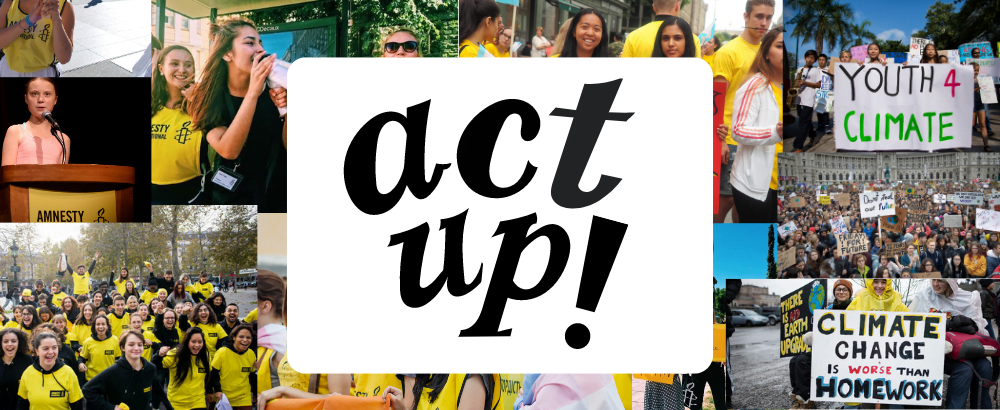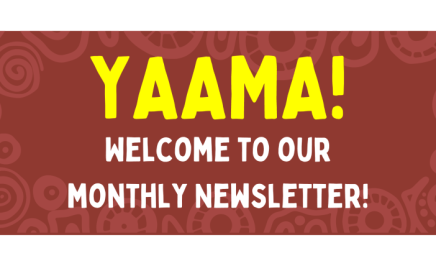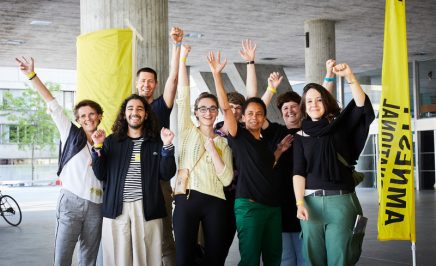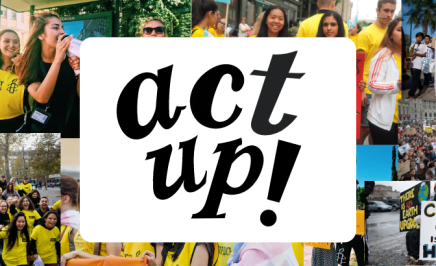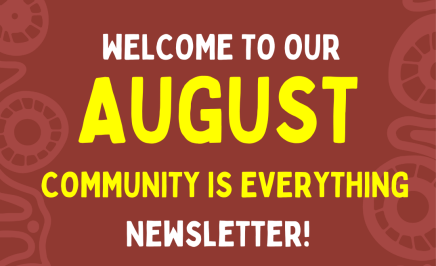Edition 4 | September 2024

Dear fellow activists,
We, the creators of this edition, would like to acknowledge the traditional protectors and custodians of the land on which we write, Amnesty International Australia operates, and where you and I reside. We pay our respect to Elders past, present, and emerging, recognising their resistance in preserving their ongoing stewardship of the land.
We’re back this month with a new edition of Act Up! this month, we are focusing on ‘Different Approaches to Activism,’ with a special emphasis on accessible activism.
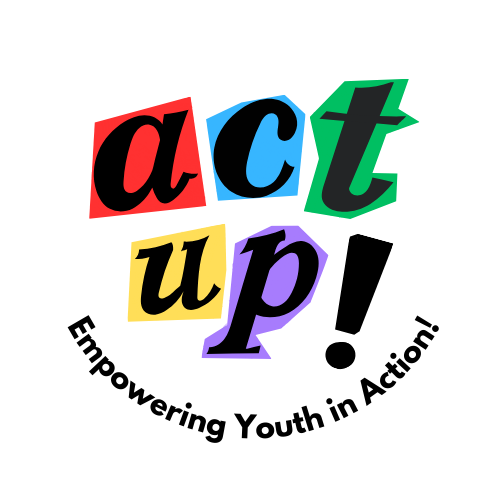
What image comes to mind when you think of activism? Do you see Greta Thunberg holding a microphone, urging the powerful to protect our Earth? Do you see millions marching down the streets of America chanting ‘Black Lives Matter’?
Have you seen images of accessible activism? Images of individuals in wheelchairs protesting for accessibility? If not, you might have seen those videos on social media by wheelchair users demonstrating the obvious flaws in accessible design at their schools, universities or in public places. These videos often use humour to highlight the essential issues of inadequate accessible infrastructure and the dehumanising effect it can have on disabled individuals. Do you believe that these posts on social media are a form of activism as well?
If you want to see a “feisty disabled person change the world,” I encourage you to look up the inspiring life of Judith “Judy” Heumann, endearingly called ‘The Mother of Disability Rights Movement’. In 1972, she staged one of the most sensational protests on Madison Avenue, NY, along with 80 other activists, to protest the veto of the Rehabilitation Act of 1973 by then-President Richard Nixon. Judith fought for her teaching licence to become the first wheelchair user to teach in NYC and continued to fight for the rights of people like herself.
The Oscar nominated documentary Crip Camp features the lives of Judith and other disabled children living at the camp. The film received critical acclaim globally and is an inspiring story worth-telling. In her powerful words, “Some people say that what I did changed the world… but really, I simply refused to accept what I was told about who I could be. And I was willing to make a fuss about it.”
In a world where activism is only reserved for those with the loudest voices or the most prominent platforms, the movement towards accessible activism is redefining the landscape. Nobody should be restricted from being an activist and fighting for what they believe in, especially because we cannot afford to lose such an essential voice to the discussion. Accessible activism ensures inclusive activism for everyone, regardless of their circumstances.
Join us as we explore how accessible activism has not only broken down barriers in social movements but also enriched them with experiences and stories that have long stayed on the periphery. This issue is a tribute to their unyielding spirit and the belief that inclusivity is empowering.
We are excited to share our thoughts and ideas on accessible activism with you and would love to hear yours! Please let us know if you have an idea for the newsletter or wish to add something to it and join in on the discussion. From a fellow youth member, this newsletter is for you and we would love for you to get involved in whatever way you’d like. If you have a question, feedback, or general inquiry, send up a message through the form below!
We hope you enjoy this edition! We look forward to hearing from you all!
In Solidarity,
Your Working Group


Learn about what other young people are up to, what they have to say and what they care about in the Amnesty Movement!
Accessible Activism: Changing the world one accommodation at a time.
Written by Vex Mulvaney (Amnesty Youth Activist)
Youth activism is becoming increasingly prevalent with the overconsumption of media through social platforms such as TikTok, Instagram, and Facebook. Young people are being forced to face the harsh reality of the current economic, political, and social climate of the world.
I consider myself one of those activists and have a strong passion for human rights lobbying. However, my disability blocks me from more traditional forms of activism.
When people think of ‘activism,’ the typical image of street protestors is common, but that popular form provides a barrier to many disabled people.
Due to my Spina Bifida, I have trouble standing for long periods, walking, and even sitting for longer than an hour due to chronic pain. Not being able to participate in this form of activism, I’ve received comments that my activism is performative. I was surprised that even in the activist community, there is still a level of ableism when it comes to protecting human rights — hypocritical, right?
In fact, according to the University of Michigan, disabled people are more likely to be politically active. So why isn’t activism representing that intersectionality? Frankly, it’s linked to the preconceived social notion of the ‘disabled identity’ that able-bodied people often subconsciously hold.
Those like myself with an invisible physical disability or people who have a mental disability are often considered not ‘disabled’ enough because we aren’t in a wheelchair or use obvious medical aids.
These harmful notions create an alienation of how disabled people should look and act.
However, by highlighting accessible ways of activism, lobbyists can create a more inclusive environment for everyone, regardless of ability. Creating more awareness about online activism — sending letters to politicians, watching documentaries, joining Zoom panels — can successfully bring accessible activism into the spotlight and encourage those who might be barred from more traditional forms to fight for their and others’ human rights.
Originally published for the Australian Youth Affairs Coalition.
From Passion to Action: Activism through Volunteering
Written by Thomas Coorey (Amnesty Youth Member)
When I say ‘activism’, I’m sure a few images spring to mind. People marching in the streets, banners unfurled. Chants and rallying cries echoing off city buildings, as a tide of people try to create sweeping change. Pamphlets and T-shirts with bright colours and catchy lines.
I love this type of activism – the energy and passion behind a good march is totally unmatched. But, this isn’t for everyone. Maybe you don’t live near a city, or you have commitments to family and school, or you aren’t comfortable with the crowds and noise. Whatever the case, there are other ways to fight for human rights.
One especially good way to do that is by volunteering. Whilst it’s often not directly calling for change, volunteerism is vitally important to help alleviate the existing suffering within our society. Campaigning for solutions to homelessness is absolutely necessary in the long term, but for now, we need to make sure we’re supporting those presently sleeping rough.
So, how can you get into volunteering? Well, if you’re reading this, you’re already halfway there. In the digital age, it has never been easier to find organisations near you that support causes you care about. Simply googling ‘Homelessness volunteering near me’ (replacing homelessness with climate change, or refugees, or anything else) will yield a bounty of opportunities and organisations needing help.
For those living in NSW, the government actually has a database of volunteer opportunities! Just search for ‘volunteering in NSW’ and you can access dozens of postings, which you can sort by activity, time commitment, and age suitability. You might be too young for some things, but there are always ways to be active behind the scenes.
None of that takes your fancy? Don’t worry, there are still more ways to volunteer. Go to a religious school? Ask a teacher about social justice programs! Do you have a local community centre? Go down and ask if they have any upcoming events! Live near a waterway or major environmental site? Look around for clean-up crews!
It could not be easier to find ways to be an activist in your local community.
Personally, I have done most of my activism through the platform of volunteering. It’s one of the most rewarding activities I do, and it’s invaluable to be able to help another person, a cause, or the environment directly.
So, even if you do spend your weekends with a banner in hand, why not giving volunteering a go? Be it a week, a month, or even just a few hours, you’ll be able to make an impact on the world.
Remember that activism takes many forms – have a crack at this one!
Amnesty Group Annual Bake Sale
Written by Mya Wu (James Ruse Agricultural HS, Amnesty Group)
On the 27th of May, the James Ruse Agricultural HS Amnesty Group hosted an annual bake sale to raise money for Amnesty International and raise awareness for the human rights violations of Palestinian civilians in Gaza and Rafah. Including selling badges, stickers and pens generously provided by Amnesty International Australia, we were able to raise ~$1500 that will go to making a difference in global humanitarian crises and supporting the organisations which aim to prevent this. It was an amazing event overall with over 200 students buying/selling baked goods made by the student body, and we are very grateful to be able to make a difference, as small as it may be, in creating a brighter future.
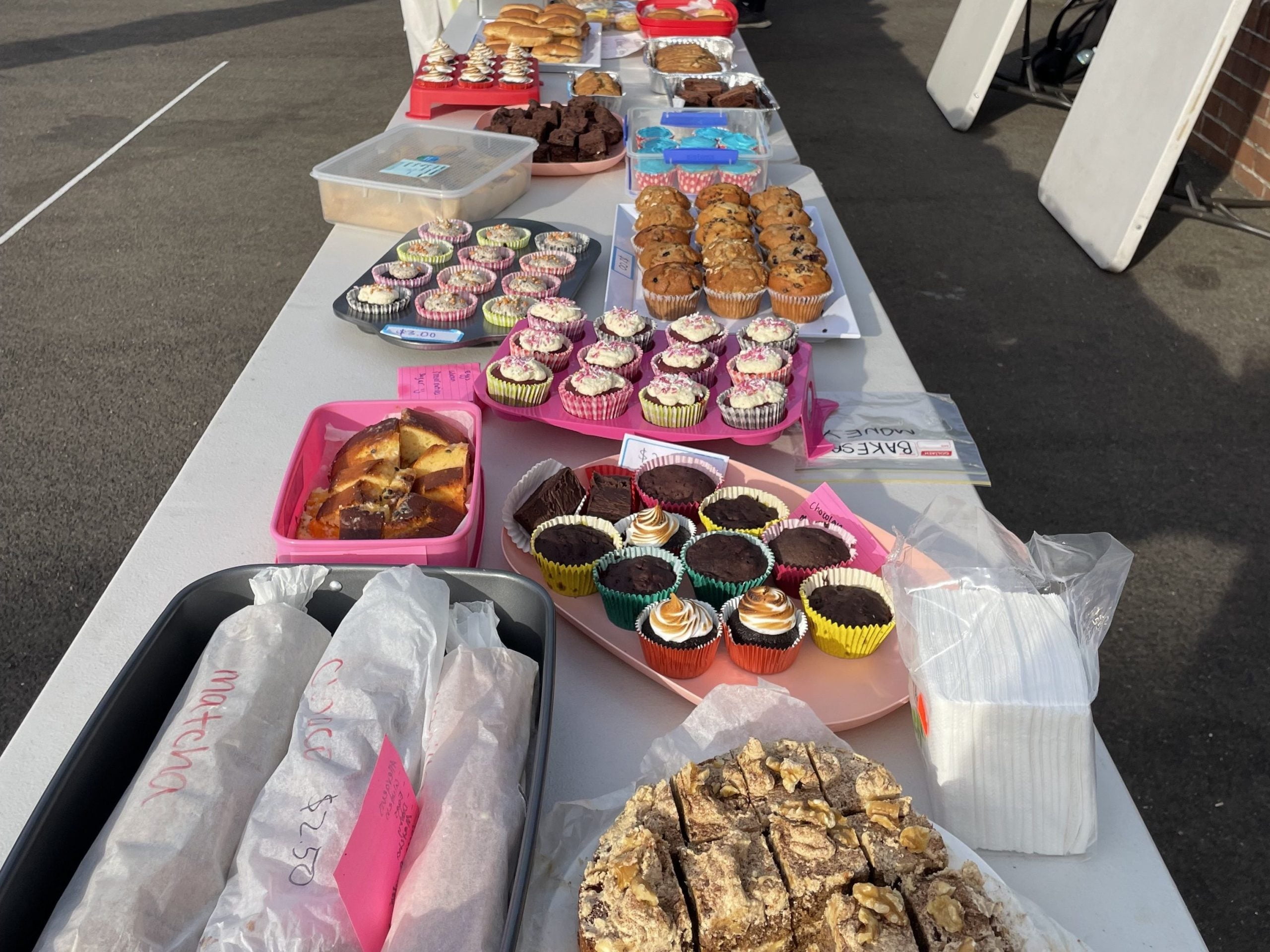


Find out what’s happening soon at Amnesty!
✍️ Be part of the world’s biggest human rights event – Write 4 Rights!
Term 4, 2024
How many letters do you think your school community could write for a cause? Host a Letter Writing Marathon with your school to help save lives! For more information and to register to be a part of this important campaign, fill out this super-quick form.
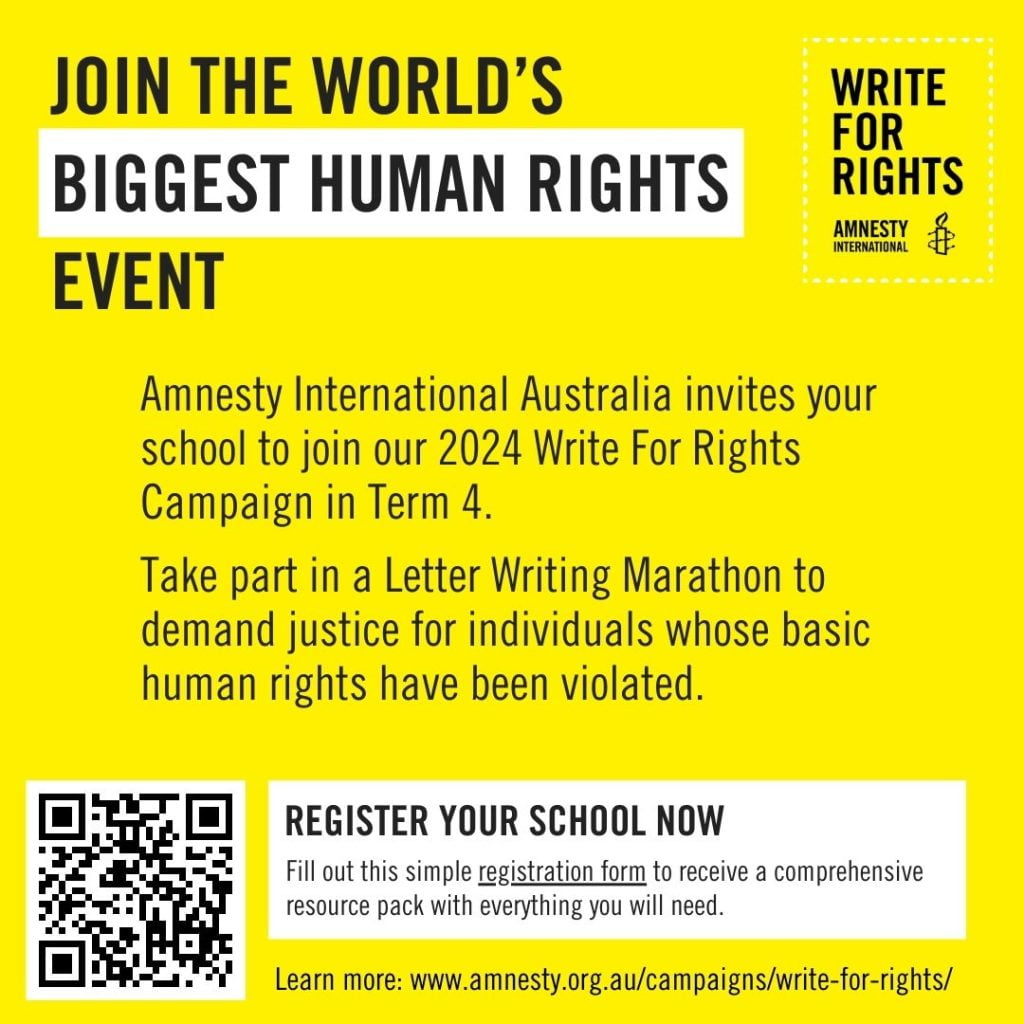
✊ Calling NSW youth to join our new Youth Action Group!
If you’re based anywhere in NSW, join the NSW Youth Action Group to get involved with activism happening in your region and lead human rights initiatives to make a difference! Please note, meetings are hybrid (offline & online options).
Join your local Amnesty Action Group to get more involved with activism on the ground!
We have just re-vamped our Action Group webpage to make it easier to navigate! Click to the button to find your local group and sign up to let them know you’d like to get involved or hear about their events and activities!

What else can you expect from the Act Up! newsletter?
As a Working Group, we are committed to publishing an edition of Act Up! once a month.
Going forward, here is what you can expect from this newsletter:
- Sharing any UPCOMING OPPORTUNITIES for fun & exciting things that are happening in the movement (i.e. Youth Action spaces, campaign events, rallies/protests, training workshops, Members Forums etc.)!
- YOUTH ACTIVIST SPOTLIGHTS where we will highlight the personal activism stories of youth activists in our movement. Every story is important and valuable so get in touch if you want to share your story!
- Sharing what young people are doing within Amnesty, in their local communities, schools, universities or at Amnesty events in our YOUTH ON THE MOVE section! Get in touch if you have been doing some cool things!
- GET IN CONTACT via the form below to have your say, share your piece or even join our working group!
We want YOU to get involved and share your experiences, stories and creative works in the human rights activism and advocacy space through the Act Up! Youth Newsletter.
Thank you for being comfortable and confident enough to share what you and your community are doing for human rights. See you next month with our next edition!

